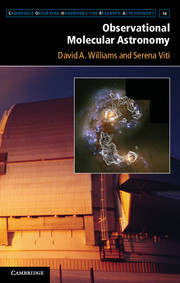Book contents
- Frontmatter
- Contents
- List of Illustrations
- List of Tables
- Preface
- 1 Introduction
- 2 Spectra and Excitation of Interstellar Molecules
- 3 Astrochemical Processes
- 4 Physical Processes in Different Astronomical Environments
- 5 Molecular Tracers in the Milky Way Galaxy
- 6 Molecular Tracers in External Galaxies
- 7 The Early Universe and the First Galaxies
- 8 Recipes for Molecular Submillimetre Astronomy
- 9 Chemical and Radiative Transfer Models
- 10 Observations: Which Molecule, Which Transition?
- Appendix: Acronyms
- Index
- References
8 - Recipes for Molecular Submillimetre Astronomy
Published online by Cambridge University Press: 05 December 2013
- Frontmatter
- Contents
- List of Illustrations
- List of Tables
- Preface
- 1 Introduction
- 2 Spectra and Excitation of Interstellar Molecules
- 3 Astrochemical Processes
- 4 Physical Processes in Different Astronomical Environments
- 5 Molecular Tracers in the Milky Way Galaxy
- 6 Molecular Tracers in External Galaxies
- 7 The Early Universe and the First Galaxies
- 8 Recipes for Molecular Submillimetre Astronomy
- 9 Chemical and Radiative Transfer Models
- 10 Observations: Which Molecule, Which Transition?
- Appendix: Acronyms
- Index
- References
Summary
It is clear that molecular line emissions can yield important information about the physical conditions of the gas and dust in our own as well as in external galaxies. What is not so clear is how to transform observational results into such physically meaningful information. This chapter aims at providing some simple recipes to aid the observer in achieving this goal. In this chapter we describe the relationships between the observable quantities in submillimetre molecular astronomy and the physical information that the observer would like to obtain. Inevitably, several approximations are made in order to derive such information, depending on the spectral and spatial resolution available, as well as the number of observable molecular transitions of any one species.
We start by relating what we measure with submillimetre and radio telescopes, that is, the antenna temperature, Ta, to the fundamental molecular constants and the relevant astronomical parameters. What we would like to know are the column densities of the observed species and the gas temperatures and number densities of the local gas. We shall describe first how to obtain these quantities if the gas is in Local Thermal Equilibrium (LTE), that is, where the level populations are dominated by collisions in a gas at a uniform temperature. The methods of obtaining this information depend on the types of molecule involved. We conclude this chapter by discussing the conversion of column densities into fractional abundances compared to the total hydrogen abundance, quantities that are directly comparable to the predictions of chemical models. In Chapter 9 we describe some approximations routinely used when LTE does not apply.
- Type
- Chapter
- Information
- Observational Molecular AstronomyExploring the Universe Using Molecular Line Emissions, pp. 141 - 151Publisher: Cambridge University PressPrint publication year: 2013



